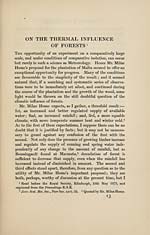Collected works > Edinburgh edition, 1894-98 - Works of Robert Louis Stevenson > Volume 28, 1898 - Appendix
(34) Page 14
Download files
Complete book:
Individual page:
Thumbnail gallery: Grid view | List view

ON THE THERMAL
wish to confine myself in the present paper to the examination
of the third alone.
A wood, then, may be regarded either as a superficies or as a
solid; that is, either as a part of the earth's surface slightly
elevated above the rest, or as a diffused and heterogeneous
body displacing a certain portion of free and mobile atmo-
sphere. It is primarily in the first character that it attracts
dtir attention, as a radiating and absorbing surface, exposed to
the sun and the currents of the air ; such that, if we imagine a
plateau of meadow-land or bare earth raised to the mean level
of the forest's exposed leaf-surface, we shall have an agent
entirely similar in kind, although perhaps widely differing in
the amount of action. Now, by comparing a tract of wood
with such a plateau as we have just supposed, we shall arrive
at a clear idea of the specialties of the former. In the first
place, then, the mass of foliage may be expected to increase
the radiating power of each tree. The upper leaves radiate
freely towards the stars and the cold inter-stellar spaces, while
the lower ones radiate to those above and receive less heat in
return ; consequently, during the absence of the sun, each tree
cools gradually downward from top to bottom. Hence we
must take into account not merely the area of leaf-surface
actually exposed to the sky, but, to a greater or less extent,
the surface of every leaf in the whole tree or the whole wood.
This is evidently a point in which the action of the forest may
be expected to differ from that of the meadow or naked earth ;
for though, of course, inferior strata tend to a certain extent to
follow somewhat the same course as the mass of inferior leaves,
they do so to a less degree — conduction, and the conduction of
a very slow conductor, being substituted for radiation.
We come next, however, to a second point of difference. In
the case of the meadow, the chilled air continues to lie upon
the surface, the grass, as Humboldt says, remaining all night
submerged in the stratum of lowest temperature ; while in the
case of trees, the coldest air is continually passing down to the
14
wish to confine myself in the present paper to the examination
of the third alone.
A wood, then, may be regarded either as a superficies or as a
solid; that is, either as a part of the earth's surface slightly
elevated above the rest, or as a diffused and heterogeneous
body displacing a certain portion of free and mobile atmo-
sphere. It is primarily in the first character that it attracts
dtir attention, as a radiating and absorbing surface, exposed to
the sun and the currents of the air ; such that, if we imagine a
plateau of meadow-land or bare earth raised to the mean level
of the forest's exposed leaf-surface, we shall have an agent
entirely similar in kind, although perhaps widely differing in
the amount of action. Now, by comparing a tract of wood
with such a plateau as we have just supposed, we shall arrive
at a clear idea of the specialties of the former. In the first
place, then, the mass of foliage may be expected to increase
the radiating power of each tree. The upper leaves radiate
freely towards the stars and the cold inter-stellar spaces, while
the lower ones radiate to those above and receive less heat in
return ; consequently, during the absence of the sun, each tree
cools gradually downward from top to bottom. Hence we
must take into account not merely the area of leaf-surface
actually exposed to the sky, but, to a greater or less extent,
the surface of every leaf in the whole tree or the whole wood.
This is evidently a point in which the action of the forest may
be expected to differ from that of the meadow or naked earth ;
for though, of course, inferior strata tend to a certain extent to
follow somewhat the same course as the mass of inferior leaves,
they do so to a less degree — conduction, and the conduction of
a very slow conductor, being substituted for radiation.
We come next, however, to a second point of difference. In
the case of the meadow, the chilled air continues to lie upon
the surface, the grass, as Humboldt says, remaining all night
submerged in the stratum of lowest temperature ; while in the
case of trees, the coldest air is continually passing down to the
14
Set display mode to: Large image | Transcription
Images and transcriptions on this page, including medium image downloads, may be used under the Creative Commons Attribution 4.0 International Licence unless otherwise stated. ![]()
| Early editions of Robert Louis Stevenson > Collected works > Works of Robert Louis Stevenson > Appendix > (34) Page 14 |
|---|
| Permanent URL | https://digital.nls.uk/99383720 |
|---|
| Form / genre: |
Written and printed matter > Books |
|---|---|
| Dates / events: |
1898 [Date published] |
| Places: |
Europe >
United Kingdom >
Scotland >
Edinburgh >
Edinburgh
(inhabited place) [Place printed] |
| Subject / content: |
Essays Anthologies |
| Person / organisation: |
Colvin, Sidney, 1845-1927 [Author of introduction, etc.] |
| Form / genre: |
Written and printed matter > Books |
|---|---|
| Dates / events: |
1894-1898 [Date printed] |
| Places: |
Europe >
United Kingdom >
Scotland >
Edinburgh >
Edinburgh
(inhabited place) [Place printed] |
| Subject / content: |
Collected works |
| Person / organisation: |
Chatto & Windus (Firm) [Distributor] Stevenson, Robert Louis, 1850-1894 [Author] T. and A. Constable [Printer] Longmans, Green, and Co. [Publisher] Colvin, Sidney, 1845-1927 [Editor] |
| Person / organisation: |
Stevenson, Robert Louis, 1850-1894 [Author] |
|---|



